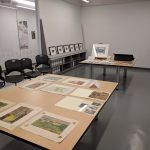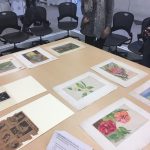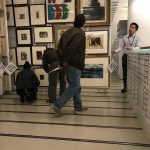Contributed by Liz McDermott, Conservation Technician
PAFA’s Richard C. von Hess Foundation Works of Art on Paper Conservation Studio is a dedicated space used to perform important preservation and exhibition related activities. From properly housing works of art on paper for storage to preparing works for exhibitions and loans, the Conservation Studio plays a vital role in supporting PAFA’s mission.
In preparation of PAFA’s upcoming exhibition, First Academies, the museum will put on display its most important document—the original 1805 Charter. Placing the charter on view highlights one theme of the exhibition—the founding of the first Academies in England (The Royal Academy of the Arts, established 1768) and the United States (The Pennsylvania Academy of the Fine Arts, established 1805). Signed inside Independence Hall on December 26, 1805, the PAFA Charter is an important piece of history not only for PAFA, but for America as well. Framing the document required the utmost care.
The Charter is written on parchment. True parchment is an animal skin which has been treated, stretched, and scraped to create a durable and long-lasting surface for writing and drawing. Parchment is hygroscopic in nature, which means that it absorbs water very readily. This causes parchment to swell in conditions of high Relative Humidity (RH). Conversely, if the RH is too low, parchment will shrink and potentially even crack. Constant fluctuations in temperature and humidity can also degrade the parchment through processes that affect the collagen and lipids in the material. This vulnerability of true parchment to unstable climate conditions made framing the PAFA Charter a welcome challenge. After hours of planning, research, and consultations with colleagues in the art conservation field, it was decided to use the methods illustrated below:
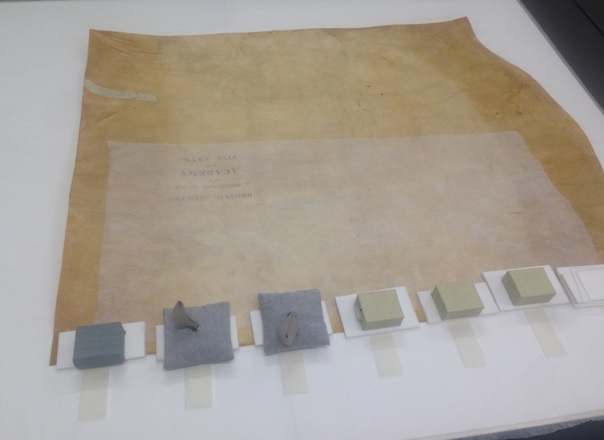
First, perimeter hinges were adhered on the verso of the Charter about 4” apart. The above picture shows the process. Japanese tissue hinges were adhered and weighted using a very dry wheat starch paste. The ends of the Japanese tissue were frayed and overlap the parchment no more than 1/8” to ensure easy and safe reversal by future conservators.
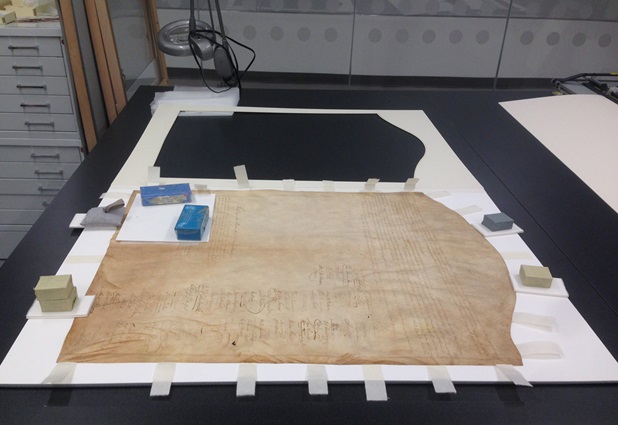
Once the perimeter hinges were adhered, the Charter was positioned into the book mat for mounting. Notice which hinges have been adhered first—like stretching a canvas (but in this case much gentler), the hinges were first attached at the center, then moving opposite and outward, the hinges were attached one by one to create even gentle tension throughout the Charter.
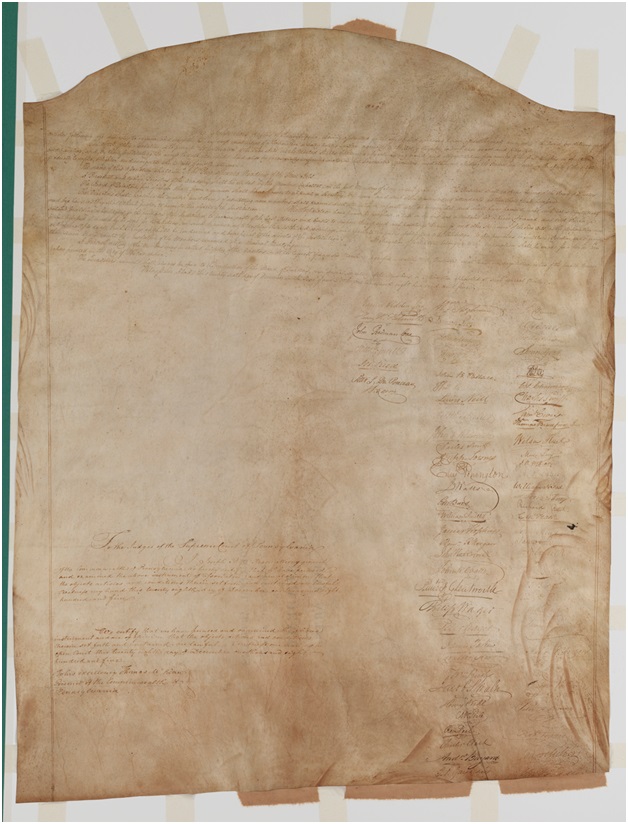
Here is the Charter after mounting (photo by Barbara Katus). Notice the toned Japanese tissue paper at the top and bottom right. This was to disguise the bright white backing mat while on view since the window mat was constructed with a substantial gap to allow freedom of movement inside of the framed package.
Next, a sealed package was constructed to maintain the parchment at an optimum RH during transport and within the gallery environment for up to a year. This technique was developed by Hugh Phibbs, former Coordinator of Preservation Services at the National Gallery of Art in Washington, DC.

The UV- filtering, non-glare plexi glazing was first placed over the mounted and matted Charter and weighted down to prevent movement. Marvelseal 360, a puncture resistant, aluminized polyethylene and nylon barrier film (used for packaging space food!!), was cut to a larger size than needed, and the Charter was placed inside. Next, a specialized double sided tape for museum housing was placed around the perimeter to hold everything together for the next stage.
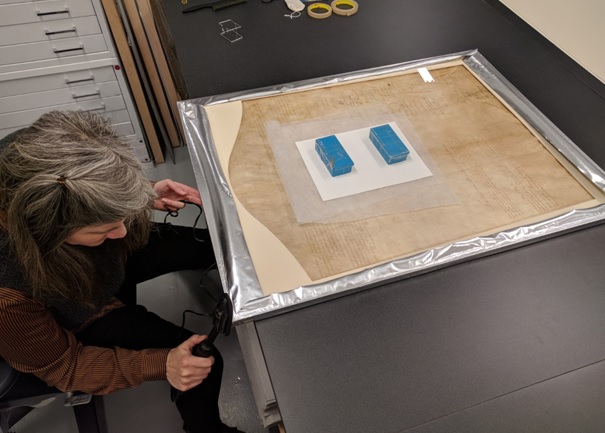
Using a tacking iron, the Marvelseal was heated around the perimeter. This completely sealed the package to prevent water vapor from leaving or entering the framed micro environment during climate fluctuations—hence the term “sealed package!” Some sealed packages have even been found to withstand flooding, and were found floating amongst the damage.
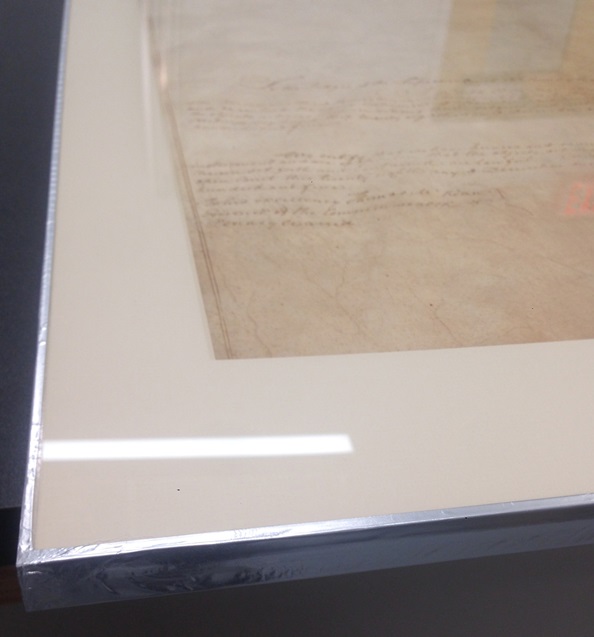
Next the edges of the Marvelseal were trimmed so that they can’t be seen beneath the rabbet of the frame while on view.
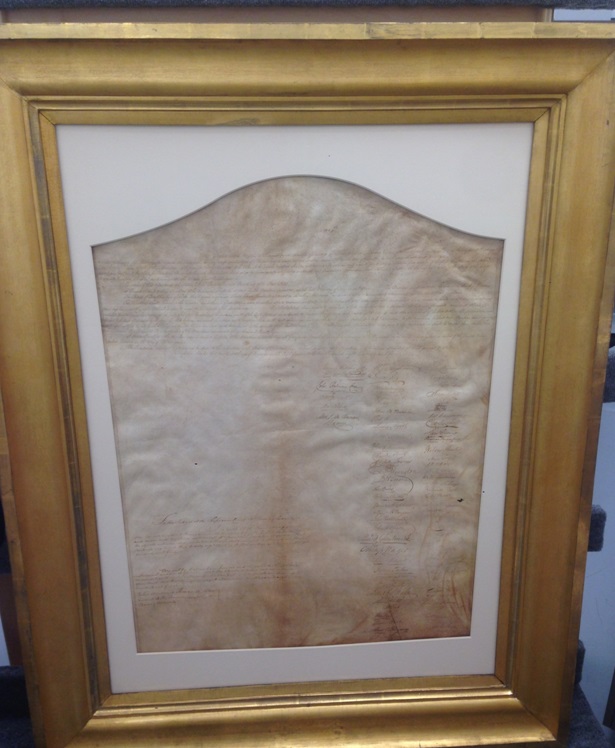
Here is the PAFA Charter fit into its new frame, ready to be enjoyed by our PAFA audience!
Be sure to come and check out First Academies, on view at PAFA from March 2nd – June 3rd in PAFA’s Historic Landmark Building!
